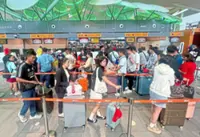KUALA LUMPUR: Frequent travellers to Singapore using land checkpoints can expect faster immigration clearance at Johor checkpoints as the QR code system will soon be implemented for car passengers.
Deputy Prime Minister Datuk Seri Fadillah Yusof said the expansion of QR code-based immigration clearance to car passengers follows the successful trial of the system for motorcyclists and bus passengers since last year.
Last year, Malaysia tested the QR system for motorcyclists and bus passengers using either the Sultan Iskandar Building (BSI) Customs, Immigration and Quarantine Complex (CIQ) at Johor Baru or Sultan Abu Bakar (KSAB) CIQ near the Second Link.
“We hope that once the procurement method is decided, we can expedite implementation.
“Our target is to extend the QR system to cars this year,” he said after the special committee meeting to address the Johor Causeway congestion at the Bukit Aman police headquarters here yesterday.
Fadillah said that QR-based clearance for motorcyclists has shown that it only takes three seconds to clear the lane.
The DPM, who chairs the special committee, said extending the system to cars is crucial to ensuring smoother entry and exit points into Malaysia, particularly as the country anticipates increased visitors and investment.
The urgency is even greater with upcoming investment hubs between Malaysia and Singapore in Johor, along with the Visit Malaysia 2026 campaign, he added.
“This committee will not only focus on entry points in Johor, but be expanded to all international entry points in the country,” he said.
Home Affairs Minister Datuk Seri Saifuddin Nasution Ismail, who was also present, said the committee prioritised motorcycles and buses as they contribute to 80% of the 500,000 daily travellers between Malaysia and Singapore.
“Alleviating congestion means finding solutions for these two modes of transportation,” he said.
According to Saifuddin, by using QR codes, 150 motorcycles can pass a customs lane in 15 minutes, whereas it was only 90 motorcycles previously.
With the successful proof of concept, he said the next step is to proceed with procurement of the QR code system, adding that the committee is also looking into solving congestion at checkpoints at Rantau Panjang (Kelantan), Bukit Kayu Hitam (Kedah), Padang Besar (Perlis), KLIA, Penang, Kota Kinabalu and Kuching.
He added that the task force also took into account the expected completion of the Rapid Transit System Link (RTS Link) by Dec 31, 2026, which forms the third land connection between Singapore and Johor with the capacity to move 10,000 passengers per hour per direction.
Also present at the press conference is Works Minister Datuk Seri Alexander Nanta Linggi and Johor Mentri Besar Datuk Onn Hafiz Ghazi.
The QR code system will replace the process of showing passports at the checkpoints, though users still have to carry the document with them.





